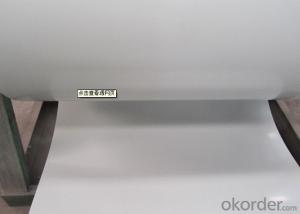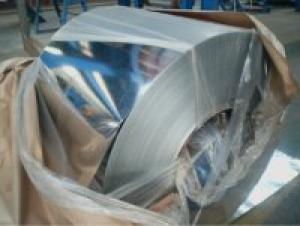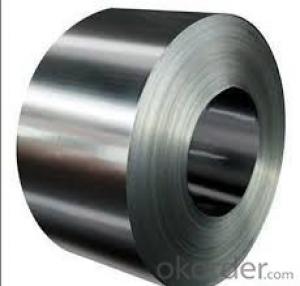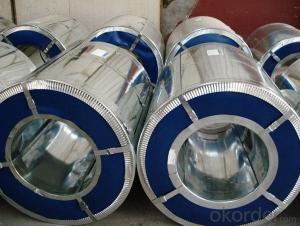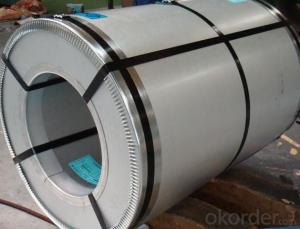Color Coated galvanized Cold Rolled Steel coil
- Loading Port:
- Tianjin
- Payment Terms:
- TT OR LC
- Min Order Qty:
- 50 m.t.
- Supply Capability:
- 300 m.t./month
OKorder Service Pledge
OKorder Financial Service
You Might Also Like
Color coated hot rolled steel coil takes hot-dip galvanized steel coil asits basic material. Factory adopts the newest technologies and the mostadvanced equipments to degrease, rinse, chemical transform the cold-rolledsteel coils or galvanized steel coils. Then we make primary and refined lavation
for the steel strips. We use worldwide advanced solidify furnace to solidify the coasting surface.This kind of color painted coils has excellent capability of decoration, molding,
corrosion resistance ability. It keeps the products with color coatings inflamboyant color for a long time.Nowadays, it has become the most perfect building materials in construction, transportation,
manufacture, light industry, office furniture, household electric appliances,
food package, and other areas all over the world.
Features:
1) Thickness: 0.2 - 1.5mm
2) Width:<1250mm< span="">
3) Lacquer: according to customer's needs
4) The color-coated steel coil is produced by hot-galvanized steel and color-coated with the paint produced according to the American standards
5) The combining force between the galvanized steel and the paint is very strong
6) The surface is polish
7) Coat fabric 2/2 (two coats for top / two coats for bottom)2/1 (two coats for top / single coat for bottom)1/1 (single coat for top / single coat for bottom)
8) Colors: white, black, sky blue, bright red, yellow
9) Can be used in building material field, galvanized wire steel tape and all other fields.
- Q:Steel roofing info. Pros and cons on steel roofing?
- Steel roofing Pro...life of product is much longer then Asphalt shingles....Looks great...multi colors.......Just love the stuff... Cons....More costly then singles at first but since it last longer it is really a better buy.......
- Q:What are the different coil leveling line configurations used for steel coils?
- The steel industry utilizes various coil leveling line configurations to meet specific requirements and preferences. Some commonly employed configurations include: 1. Straightener: Employed to rectify coil shape defects or distortion. It consists of rollers that gradually straighten the coil. 2. Leveler: Ensures consistent thickness throughout the coil. Utilizes rollers to flatten the coil to the desired thickness. 3. Combination Straightener/Leveler: Integrates both straightening and leveling functions into a single machine. Combines rollers and straightening elements for shape correction and thickness leveling in one pass. 4. Looping Pit: Allows continuous processing of accumulated coils. Serves as a buffer between the entry and exit sections of the leveling line, accommodating variations in coil supply and demand. 5. Tension Leveler: Applies tension during leveling to remove shape defects and achieve a flat, uniform surface. 6. Rotary Shear: Incorporates a synchronized rotary shear to cut the leveled coil accurately and precisely. These examples showcase the diverse coil leveling line configurations used in the steel industry. The choice of configuration depends on factors such as desired product specifications, coil dimensions, processing speed requirements, and budget considerations.
- Q:What are the different types of steel coil edge conditioning methods?
- There are several different types of steel coil edge conditioning methods, including slitting, trimming, deburring, chamfering, and edge rolling.
- Q:I need a machine which can produce steel pipes, but I don't know where to look...If you want me to state dimensions etc. just say...Thanks :)
- Gary's okorder /
- Q:What are the different types of steel coatings for coils?
- Coils can be coated with various types of steel coatings, each with its own unique properties and advantages. Some of the most commonly used coatings include: 1. Galvanized Coating: This type of steel coating is widely utilized for coils. It involves applying a layer of zinc to the steel, which provides excellent protection against rust and corrosion. It is particularly suitable for outdoor applications or environments with high moisture levels. 2. Galvannealed Coating: Galvannealed steel coating involves subjecting the galvanized steel to additional heat treatment, resulting in a matte finish and improved adhesion for paint. It offers enhanced corrosion resistance and is often preferred in the automotive and construction sectors. 3. Aluminized Coating: Coating steel coils with aluminum provides outstanding heat resistance and corrosion protection. Aluminized steel is commonly employed in exhaust systems and other applications involving high temperatures. 4. Organic Coatings: Steel coils can also be coated with organic materials like paints or powder coatings. These coatings offer additional protection against corrosion and can be customized to meet specific aesthetic requirements, available in a wide range of colors. 5. Tin Coating: Tin-plated steel coils are covered with a layer of tin, which provides excellent solderability and resistance to corrosion. This type of coating is frequently used in the production of cans and other food packaging materials. 6. Phosphate Coating: Phosphate coatings are often applied as a pre-treatment before other coatings to enhance adhesion and corrosion resistance. They create a thin, crystalline layer on the steel surface, facilitating better adhesion of paint or powder coatings. These examples illustrate the diversity of steel coatings available for coils. The choice of coating depends on specific application requirements, considering factors such as corrosion resistance, heat resistance, paint adhesion, and aesthetic preferences.
- Q:Could someone please explain what happens when steel is heat treated and why these happenings cause the steel to become harder? Please dig down into the micro details of the crystallites but in somewhat laymen's terms. Also describe the processes which achieve these results; if you have the time. Thanks for your time and effort.
- Alright, usually whu heat you heat treat mild steel, this is because you would like it stronger than you got it. To do this you must alter the grain structure of the part or in other words, the CRYSTALLITES. Ultimately you'll end up altering the nature of the grains structure changing the tensile strength it can handle, yield strength, and even change the elongation percentage that it can tolerate under load. Heat treatment controls the rate of diffusion, and the rate of cooling within the microstructure to create these elements. Usually what they use to do this is add an element to it to make it stronger such as carbon to increase its rockwell hardness, which by the way the lower you go the harder the part can become. Heat treatment can be used in more ways than this. It can also be used to weaken the parts grain structure. This will lower the parts mechanical properties making it softer and more ductile or easier to manipulate if you have to bend it into a particular shape. Typically if you allow the part to cool after heat treatment it does go through annealing. The part will be heat treated into different stages. The first being the austenitic crystal phase which depending on how hard and strong you want it, will be at its peak. When it is cooled, it will go through a will transform to martensite which is a hard yet brittle crystalline structure. Martenised part will usually be tempered to a certain degree to improve the mechanical properties to what is needed. There is more to this and you can use the link below to read more about it.
- Q:I do a lot of scrapping and would like to be able to separate stainless steel from regular steel. The magnet test doesn't always work since stainless can be magnetic, but what are some ways that I can for sure tell the difference? Or even something like a sound that they make that may help me to tell the difference.
- Stainless steel uses chromium in its mixture to thwart the affects of corrosion. General steel, or carbon steel, is generally almost completely iron and is used for far greater applications than stainless steel. Stainless steel is used mostly in kitchen appliances, utensils, etc... The best thing I can come up with is to find a way to measure the chromium content of the steel you are looking at. If it's around 3% chromium, it's probably standard steel. If it's somewhere between 10-15% chromium it's probably stainless steel (or even 4% plus). I can't tell you a fast and quick way to test the steel because from my research, it appears there are as many grades and allows of steel as there are uses for steel! There is one test I've seen for home testing surgical steel which is a higher grade stainless steel, that is to put scotch tape on one section of material then soak it in water for a 24 hour period, then let it air dry for 24 hours. You remove the tape and lightly polish the exposed areas to see if there was any discoloration or pitting on the exposed area. This test is mainly for surgical steel jewelry, however stainless steel is supposed to resist rusting more than standard steel, hence it might work for other steel types as well. You may have to read some of the other links below to get some other ideas on how you can test steel to see if it is stainless.
- Q:I know this is an alloy, but can it be mixed to form a superior steel? Therefore less likely to stain?
- Unfortunately the stainless property does not make a 100% superior blade, unless you are not too concerned with how it performs. Generally speaking the mineral that allows steel not to stain is chromium so the higher content of chromium the more shiny and less likely to stain. The best performing blades however are the ones resistant to fatigue that usually contain high silica levels like japanese blades. Chromium on the other hand does make a less flexible and lower quality blade that also needs to be thicker, so it comes down to what will you be using it for.
- Q:My mother is in a weilding class, and today she accidentally welded Galvanized Steel. She doesn't feel good and she wants to know what the symptoms are for Galvanized Poisoning from breathing in the Fumes. Please help, I am worried for her.
- Pot stands and stoves constructed from galvanized steel can cause metal fume fever when heated. This is caused by the inhalation of zinc oxide fumes or dust produced when galvanized steel is welded or burned. The signs and symptoms can be vague (shaking chills, fever, body aches, headache, and fatigue) and are similar to those of the flu or a viral illness.
- Q:What is the role of steel coils in the manufacturing of agricultural machinery?
- Steel coils are essential in the manufacturing of agricultural machinery as they are used to form various components such as frames, chassis, and structural supports. These coils provide the necessary strength, durability, and rigidity required to withstand the demanding conditions and heavy workload typically encountered in the agricultural sector.
1. Manufacturer Overview |
|
|---|---|
| Location | |
| Year Established | |
| Annual Output Value | |
| Main Markets | |
| Company Certifications | |
2. Manufacturer Certificates |
|
|---|---|
| a) Certification Name | |
| Range | |
| Reference | |
| Validity Period | |
3. Manufacturer Capability |
|
|---|---|
| a)Trade Capacity | |
| Nearest Port | |
| Export Percentage | |
| No.of Employees in Trade Department | |
| Language Spoken: | |
| b)Factory Information | |
| Factory Size: | |
| No. of Production Lines | |
| Contract Manufacturing | |
| Product Price Range | |
Send your message to us
Color Coated galvanized Cold Rolled Steel coil
- Loading Port:
- Tianjin
- Payment Terms:
- TT OR LC
- Min Order Qty:
- 50 m.t.
- Supply Capability:
- 300 m.t./month
OKorder Service Pledge
OKorder Financial Service
Similar products
New products
Hot products
Hot Searches
Related keywords
